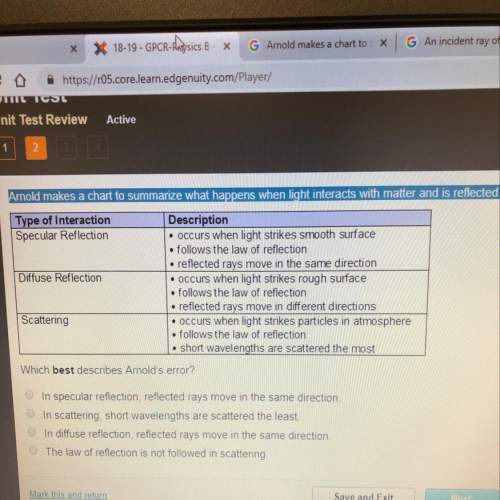
Physics, 10.04.2020 19:18 destinyterrea
Describe the differences between mechanical and chemical weathering processes. a. Weathering processes are continuous at all times on the earth’s surface. Rocks are weathered both through mechanical and chemical processes as rock material changes composition or becomes chemically altered into smaller pieces, ultimately reaching physical and chemical balance. Mechanical weathering, such as frost wedging and exfoliation processes work to physically break down rock and expose larger surface areas which accelerates the physical and chemical reactions brought on as the result of chemical and mechanical weathering. Examples of mechanical weathering include the reaction of atmospheric CO2 and water (carbonic acid), frost wedging and tree roots disrupting curbs and breaking through solid rock. Chemical weathering results in the formation of clay particles. For example, the reaction of carbonic acid with solid granite can completely alter feldspar minerals into fine-grained quartz materials. In fact, chemical weathering ultimately reduces solid rock material into clay particles over time. An example of chemical weathering can be as simple as a rusted nail. b. Weathering processes are continuous at all times on the earth’s surface. Rocks are weathered both through altering the rock’s physical make-up and chemical processes in which rocks chemically break down or become lithified chemically, reaching a balance between its physical and chemical environment. Mechanical weathering, transportation of regolith and unloading work to break down rock and expose uplifted exfoliation domes which accelerates the chemical ionic and mechanical weathering compounds. Examples of mechanical weathering include granular disintegration, expansion and tree roots disrupting curbs and breaking through rock. Chemical weathering results in various positive feedback processes that promote the formation of fine-grained material untimely forming insitu clay residue. For example, the reaction of carbonic acid with solid granite can completely alter minerals into kaolinite clay. In fact, chemical weathering ultimately reduces solid rock forming various soil horizons which depend the factors such as topography, climate, and time. An example of chemical weathering can be as simple as a rusted nail. c. Weathering processes are continuous at all times on the earth’s surface. Rocks are weathered both through mechanical and chemical processes as rock material breaks down or becomes chemically altered, ultimately reaching physical and chemical equilibrium with its surroundings. Mechanical weathering, such as frost wedging and unloading work to physically break down rock and expose larger surface areas which accelerates chemical and mechanical weathering. Examples of mechanical weathering include granular disintegration, expansion of ice breaking rock material and tree roots disrupting curbs and also able to break through solid rock. Chemical weathering results in changing rock material to a complete different chemical compound. For example, the reaction of carbonic acid with solid granite can completely alter orthoclase minerals into kaolinite clay. In fact, chemical weathering ultimately reduces solid rock material into clay particles over time. An example of chemical weathering can be as simple as a rusted nail.

Answers: 2
Another question on Physics

Physics, 22.06.2019 02:30
Power can be defined as a. the distance over which work was done. b. how much work can be done in a given time. c. all the work in an given area. d. the energy required to do work.
Answers: 1

Physics, 22.06.2019 07:50
2. -/1 pointsserpse10 2.7.p.017.mi. an object moving with uniform acceleration has a velocity of 14.0 cm/s in the positive x direction when its x coordinate is 2.97 cm. if its x coordinate 2.85 s later is -5.00 cm, what is its acceleration? cm/s2 need ? read it master it
Answers: 1

Physics, 22.06.2019 11:30
(2) (a) you have a simple circuit that consists of only a battery (δvbat=1.5v) and two resistors with resistance r1=10ω and r2=5ω, connected in series with each other. what is the current running through the battery? (b) you re-arrange your circuit so now r2 is attached in parallel to r1 rather than in series. what is the current running through the battery? (c) you add an additional resistor r3=7ω on the same branch as r2. what is the current running through the battery? (d) what is the power dissipated in r3?
Answers: 3

Physics, 22.06.2019 14:30
Aweight lifter raises a 1600 n barbell to a height of 2.0 meters. how much work was done? w = fd a) 30 joules b) 3000 joules c) 320 joules d) 3200 joules
Answers: 2
You know the right answer?
Describe the differences between mechanical and chemical weathering processes. a. Weathering process...
Questions

Mathematics, 16.11.2020 20:40


Mathematics, 16.11.2020 20:40




Computers and Technology, 16.11.2020 20:40



Mathematics, 16.11.2020 20:40

Mathematics, 16.11.2020 20:40

Mathematics, 16.11.2020 20:40

Mathematics, 16.11.2020 20:40


Mathematics, 16.11.2020 20:40

Biology, 16.11.2020 20:40

Social Studies, 16.11.2020 20:40

Mathematics, 16.11.2020 20:40

SAT, 16.11.2020 20:40




